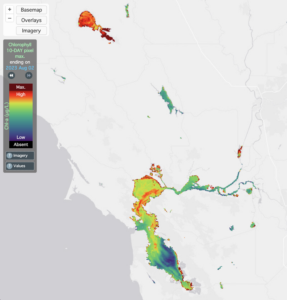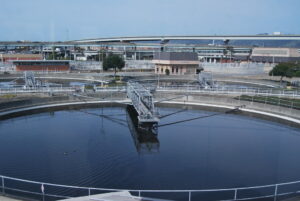Solstice is nigh, the tide is high, the full moon illuminates the midnight beach, and before us, thousands of glimmering fish wiggle out of the surf to spawn in the sand.
In Southern California beach culture, the annual return of grunion to spawn on the highest tides of the late spring and early summer are high holidays of the liturgical calendar. All evening, families and couples huddle under blankets waiting for the first fish to arrive. Some people gather the fish for the table; for others, the opportunity to witness hundreds of silvery fish dancing on the beach in the moonlight is reason enough. Now, we in the Bay Area can see the wonder of a grunion run—in 2005, they were recorded spawning here for the first time in at least 140 years.
Grunion, Leuresthes tenuis, are in the silverside family, which includes the more abundant jacksmelt and topsmelt. The grunion’s odd spawning behavior distinguishes them from their cousins. Shortly after the highest tides, the females swim up onto the beach and bury their tail ends in the sand, releasing eggs. The males then wrap around the females to fertilize the eggs. The eggs incubate in the sand, where they are protected from marine predators. When high tides return two weeks later, the young hatch and within seconds wash out to sea.
Though grunion are more numerous in the warmer waters of Southern California, William Ayres first described the species in 1861 from a fish purchased at a market in San Francisco, where the single specimen was —brought to the market in the company of other smelts.— We cannot know if that grunion was caught in San Francisco Bay, but in those days, fish were not transported from afar. After that single specimen, grunion were not recorded in San Francisco Bay until 2001.
When Kathy Hieb of the California Department of Fish and Game and other researchers examined the catch of a Bay fish trawl in 2001, the other silversides, with which grunion might have easily been confused, lay on the deck like fish out of water. The grunion stood out immediately—they were doing the same flipping dance they do on the beaches when spawning. Then, in 2002, biologists from PRBO Conservation Science recognized grunion among the fish accidentally dropped by adult terns returning to the nesting colony at the Alameda Naval Air Station.
In 2004, Karen Martin from Pepperdine University (and organizer of grunion monitoring efforts in Southern California) teamed up with Port of Oakland scientists Andy Jahn and Jody Zaitlin to search local beaches for grunion eggs, without success. However, in 2005, Martin and Zaitlin recruited Bay Area residents to do a grunion survey. In May 2005, they observed spawning grunion in Alameda, where the fish have spawned each year since. Martin prefers not to say exactly where the spawning occurred—the run is small enough that too much attention could cause real trouble. Even smaller runs have been recorded in Tomales Bay.
Had grunion been in the region all along, avoiding notice, or had they disappeared from the region and returned? Scientists suspect the latter, and changes in ocean temperature are the most likely explanation. A three-year El Nino event preceded the 1861 description, and the 2001 collection was preceded by a period of warmer water with several large El Nino events. Martin’s recent DNA work suggests that the current Bay population was only recently established. El Ninos and other well-documented temperature cycles may control the ability of grunion to move into the Bay Area. (A global warming connection would be challenging to prove, since these other cycles create ocean temperature variations larger than we have seen to date from global warming, and they are significant enough to explain the grunion’s apparent arrival.)
Once here, grunion face a dilemma. The water in the Bay is warmer than the ocean, so this should be preferred habitat. However, the Bay is subject to low salinity levels from springtime freshwater runoff. In early 2006, for example, high runoff may have contributed to a significant grunion population decline.
Studying the fish here at the edge of their distribution, where limiting factors become obvious, can yield good insight into grunion biology. To see the fish for yourself, go to grunion.org and sign up for the May 5 Oakland Grunion Greeter training; then you’ll be able to witness a seasonal delight and contribute to science at the same time.

.jpg)



